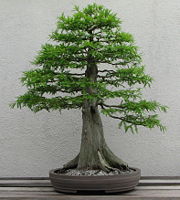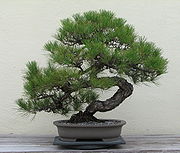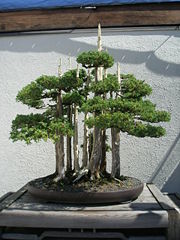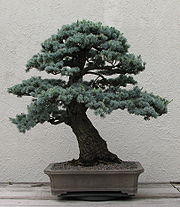
Bonsai aesthetics
Encyclopedia

Bonsai
is a Japanese art form using miniature trees grown in containers. Similar practices exist in other cultures, including the Chinese tradition of penjing from which the art originated, and the miniature living landscapes of Vietnamese hòn non bộ...
aesthetics are the aesthetic goals and characteristics of the Japan
Japan
Japan is an island nation in East Asia. Located in the Pacific Ocean, it lies to the east of the Sea of Japan, China, North Korea, South Korea and Russia, stretching from the Sea of Okhotsk in the north to the East China Sea and Taiwan in the south...
ese tradition in the art of growing a miniature tree in a container. Many Japanese cultural characteristics, particularly the influence of Zen Buddhism and the expression of wabi or sabi
Wabi-sabi
represents a comprehensive Japanese world view or aesthetic centered on the acceptance of transience. The aesthetic is sometimes described as one of beauty that is "imperfect, impermanent, and incomplete"...
, inform the bonsai tradition in that culture. As well, a lengthy catalog of conventional tree shapes and styles
Bonsai styles
Bonsai is a Japanese art form using miniature trees grown in containers. Similar practices exist in other cultures, including the Chinese tradition of penjing from which the art originated, and the miniature living landscapes of Vietnamese hòn non bộ, but this article describes the Japanese...
helps provide cohesion to the Japanese styling tradition. A number of other cultures around the globe have adopted the Japanese approach to bonsai, and while some variations have begun to appear, most hew closely to the rules and design philosophies of the Japanese tradition.
The aesthetics of penjing, a Chinese form of container-grown tree, are distinct from those of bonsai and are discussed elsewhere
Penjing
Penjing , also known as penzai , tray landscape, potted scenery, potted landscape, and miniature trees and rockery is the ancient Chinese art of growing trees and plants, kept small by skilled pruning and formed to create an aesthetic shape and the complex illusion of age...
. The aesthetics of saikei
Saikei
literally translates as "planted landscape". It is the art of creating tray landscapes that combine miniature living trees with soil, rocks, water, and related vegetation in a single tray or similar container...
, Japanese multi-tree landscapes in a container, are also distinct and are not described in this article.
Bonsai aesthetics



Bonsai styles
A key design practice in bonsai is a set of commonly-understood, named stylesBonsai styles
Bonsai is a Japanese art form using miniature trees grown in containers. Similar practices exist in other cultures, including the Chinese tradition of penjing from which the art originated, and the miniature living landscapes of Vietnamese hòn non bộ, but this article describes the Japanese...
that describe canonical
Canonical
Canonical is an adjective derived from canon. Canon comes from the greek word κανών kanon, "rule" or "measuring stick" , and is used in various meanings....
tree and setting designs. These well-known styles provide a convenient shorthand means for communicating about existing bonsai and for designing new ones. Bonsai styles describe a number of basic attributes of a bonsai, such as the angle and straightness of its trunk, its branch configuration, and the number of trees in the bonsai container.
The system of styles serves many purposes, some practical, some aesthetic. In their simplest and most common application, styles provide a form of shorthand description for bonsai specimens. Predefined styles also aid the designer in making a development plan for a pre-bonsai tree. The untrained specimen may have characteristics that suggest or rule out certain styles. The designer can evaluate the pre-bonsai specimen against the catalog of accepted styles to determine what branches to remove or reshape, what foliage to remove or encourage, and what detailed shaping to apply to trunk and branches.
As with all aesthetic rules or guidelines, the various accepted styles will guide a bonsai designer, but are not completely deterministic. The species of the bonsai, the age of the tree when it began bonsai training, the tree's pre-existing shape and structure, even the bonsai artist's training and preferences, strongly affect the shape of the resulting bonsai. These competing influences ensure that the style system acts mostly as a creative aid, not a dominating constraint, in producing a finished bonsai.
General aesthetic principles
The main aim of bonsai aesthetic practices is to create miniature trees with an air of age in their overall shapes, proportions, and details. The quintessential bonsai is a single, dwarfed tree in a small container. It has the appearance of a mature tree, but not of a completely natural one. Instead, a designer or artist has manipulated the shape and surfaces of the tree to enhance or exaggerate the tree's apparent age, and also to give it a defined "front" from which it is meant to be viewed. Anyone questioning the effect of the bonsai designer's work can test the quality of the design by viewing it from the rear, where exactly the same trunk and branches will generally look awkward, cluttered, or otherwise unattractive.No trace of the artist
At the same time, the designer's touch must not be apparent to the viewer. If a branch is removed in shaping the tree, the scar will be placed at the "back" of the tree where it cannot be seen. Alternatively, the tree will not be shown until the scar has been covered by years of bark growing over it, or a stub of the branch will remain to be cleaned and shaped into looking like it was broken by wind or lightning. Similarly, wiring should be removed or at least concealed when the bonsai is shown, and must leave no permanent marks on the branch or bark.Visual balance
Other guidelines address the balance of visual weight among the trunk, roots, foliage, and branches. The extensive catalog of recognized tree stylesBonsai styles
Bonsai is a Japanese art form using miniature trees grown in containers. Similar practices exist in other cultures, including the Chinese tradition of penjing from which the art originated, and the miniature living landscapes of Vietnamese hòn non bộ, but this article describes the Japanese...
form part of this set of guidelines. The term "balance" here may refer to either:
- static visual balance, where careful application of symmetry leads to a stable and restful shape (like the formal upright, or Chokkan, style), or
- dynamic visual balance, which may arise from an asymmetric shape or one that implies instability and movement (like the cascade, or Kengai, style).
The trunk, roots, foliage, and branches are manipulated through a variety of techniques to meet the designer's goals of visual balance. Negative spaces (the "empty space" between solid elements like branches or foliage) are also shaped and proportioned to appear in balance. In almost all designs, the viewer can see completely through the tree's negative spaces to the background behind it. In this combination of positive and negative shapes, bonsai aesthetics overlap to a certain extent with the aesthetics of sculpture
Sculpture
Sculpture is three-dimensional artwork created by shaping or combining hard materials—typically stone such as marble—or metal, glass, or wood. Softer materials can also be used, such as clay, textiles, plastics, polymers and softer metals...
.
Proportion among elements
Another general guideline touches on the proportion of the bonsai's various elements. The most prized proportions mimic those of a full-grown tree as closely as possible. Slender branches with heavy leaves or needles that are out of proportion are avoided, as is a thin trunk with thick branches. One of the few exceptions to this guideline is that flowers and fruit (on trees that produce them) are not considered to be flawed if they appear too large for the tree.Flexibility of the rules
One or more of the accepted rules of bonsai form can be bent or broken for a particular tree without destroying its fundamental aesthetic and artistic impact. In fact, going beyond the prescribed rules allows aesthetic growth in the bonsai art, as seen in many of the masterpieces created by Masahiko Kimura and Kunio Kobayashi.General aesthetic guidelines
The following characteristics are desirable in many Japanese bonsai and other styles of container-grown treeTree
A tree is a perennial woody plant. It is most often defined as a woody plant that has many secondary branches supported clear of the ground on a single main stem or trunk with clear apical dominance. A minimum height specification at maturity is cited by some authors, varying from 3 m to...
s, whatever the style:
Gravitas
This is the trait which all of the remaining points of aesthetics seek to create. It is a sense of physical weight, the illusion of mass, the appearance of maturity or advanced age, and the elusive quality of dignity. Many of the formal rules of bonsai help the grower create a tree that expresses wabi or sabiWabi-sabi
represents a comprehensive Japanese world view or aesthetic centered on the acceptance of transience. The aesthetic is sometimes described as one of beauty that is "imperfect, impermanent, and incomplete"...
, or portrays an aspect of mono no aware
Mono no aware
, literally "the pathos of things", also translated as "an empathy toward things", or "a sensitivity to ephemera", is a Japanese term used to describe the awareness of , or the transience of things, and a gentle sadness at their passing.-Origins:...
.
Miniaturization
By definition, a bonsai is a tree which is kept small enough to be container-grown while otherwise fostered to have a mature appearance. Bonsai can be classified according to size. Mame are ideally less than 10 cm (4 inches) tall and can be held in the palm of the hand. Shohin are about 25 cm (10 inches) tall, while other bonsai are larger and can not be easily moved. For both practical and aesthetic reasons, the guidelines outlined here are generally most effective and most often applied to larger bonsai, while the smallest specimens of bonsai may adhere to no rules other than "miniature tree" and "grown in a container".Lignification
This refers to enhancing the “woody-ness” of a bonsai’s trunk and branchBranch
A branch or tree branch is a woody structural member connected to but not part of the central trunk of a tree...
es so that they have a mature appearance. This typically means the bark surface is encouraged to become rough and dark-colored. In some cases this aesthetic technique will vary, as in a birch
Birch
Birch is a tree or shrub of the genus Betula , in the family Betulaceae, closely related to the beech/oak family, Fagaceae. The Betula genus contains 30–60 known taxa...
tree bonsai attaining the white colour and exfoliating bark
Exfoliation (botany)
Exfoliation means the removal or loss of leaves from a plant. It is used both to describe the loss of a leaves as a natural part of a plant’s life cycle or because of some trauma or outside cause Exfoliation (from the term "foliate", meaning “related to leaves”) means the removal or loss of...
of a mature specimen.
Asymmetry
Bonsai aesthetics discourage strict symmetry in branch and root placement. Radial symmetry is nearly always broken by the requirement for a clear "front", which exposes the tree's trunk and major branches. The left, right, and back sides will have more branches than the front. Left-right (bilateral) symmetry across the trunk is also discouraged, and designers work to alternate branches among the left, right, and back parts of the tree without ever placing two branches at the same height or extending two branches the same distance away from the trunk.Leaf Reduction
LeafLeaf
A leaf is an organ of a vascular plant, as defined in botanical terms, and in particular in plant morphology. Foliage is a mass noun that refers to leaves as a feature of plants....
reduction is related to the general miniaturization described above but is something which varies over the life cycle of a particular bonsai. For example, a bonsai’s leaves might be allowed to attain full size for many years in order to encourage vigor and growth of trunk, roots, and branches. It is usually desirable to attain a degree of leaf reduction prior to exhibiting a bonsai. Leaf reduction may be encouraged by pruning and is sometimes achieved by the total defoliation of a bonsai during one part of its growing season. Conifer needles are more difficult to reduce than other sorts of foliage.
Nebari
Also known as "buttressing", nebari is the visible spread of roots above the growing medium at the base of a bonsai. Nebari help a bonsai seem grounded and well-anchored and make it look mature, akin to a full-sized tree.Ramification
RamificationRamification (botany)
In botany, ramification is the divergence of the stem and limbs of a plant into smaller ones, i.e. trunk into branches, branches into increasingly smaller branches, etc. Gardeners stimulate the process of ramification through pruning, thereby making trees, shrubs and other plants bushier and...
is the splitting of branches and twigs into smaller ones. It is encouraged by pruning and may be integrated with practices that promote leaf reduction.
Deadwood
Bonsai artists sometimes create or emphasize the appearance of dead wood on a bonsai tree, reflecting the occasional presence of dead branches or snags on full-sized trees. Two specific styles of deadwood are jin and shari. The presence of deadwood is not as common as most of the other points mentioned here, but can be used very effectively on selected tree species and bonsai styles. See deadwood techniques for more details.Curvature
Trunk and branch curvature or contortion is an optional goal. Bonsai can achieve a sense of age while remaining straight and upright, but many bonsai rely upon curvature of the trunk to build the illusion of weight and age. Curvature of the trunk that occurs between the roots and the lowest branch is known as tachiagari. Branches are also curved and recurved to help them fit the designer's requirement for "positive space", and to separate small branches so that they do not cross or collide.Concrete aesthetic guidelines
To support the general goals and principles of bonsai aesthetics, a number of detailed heuristics are taught in the bonsai tradition and documented in its literature (somewhat similar to the bonsai styles). Example guidelines include:- The tree will appear in a formal container, relatively small compared to the tree.
- Except for the tree(s) and optional patches of moss, no other plant should appear in a bonsai container.
- Except for the vegetation, soil, and natural-looking rocks, no other object should appear in a bonsai container.
- The tree will have a distinct "front" from which it is intended to be viewed.
- The trunk should taper significantly from base to top.
- The tree's rootage should be exposed at the base of the trunk and should flare wider than the trunk as it enters the ground.
- No visible roots should cross each other.
- Branches should begin about one-third of the way up the trunk, and be continuous from there to the tip of the trunk (this guideline is specifically broken for the literati, or Bunjin-gi, style).
- Branch size should diminish from the base to the top of the tree.
- No major tree branch should cross the trunk when viewed from the tree's "front".
- Branch ramificationRamification (botany)In botany, ramification is the divergence of the stem and limbs of a plant into smaller ones, i.e. trunk into branches, branches into increasingly smaller branches, etc. Gardeners stimulate the process of ramification through pruning, thereby making trees, shrubs and other plants bushier and...
, particularly in deciduous trees, should increase towards the tip of each branch. - Branch shape should reflect the weight of age, particularly in conifers, and branches may be shaped to tend downwards toward the tip in support of this practice.
- The trunk may be a straight vertical shape or may be contorted in different directions over its length, but in styles where the tip of the tree is above the container, the tip should tilt slightly forward at the top (toward the viewer).
- Foliage (leaves or needles) should be small and to scale with the tree and its branches.
- All trees in a multi-tree bonsai planting should be of the same species.
See also
- BonsaiBonsaiis a Japanese art form using miniature trees grown in containers. Similar practices exist in other cultures, including the Chinese tradition of penjing from which the art originated, and the miniature living landscapes of Vietnamese hòn non bộ...
- Bonsai stylesBonsai stylesBonsai is a Japanese art form using miniature trees grown in containers. Similar practices exist in other cultures, including the Chinese tradition of penjing from which the art originated, and the miniature living landscapes of Vietnamese hòn non bộ, but this article describes the Japanese...
- conventional styles in the Japanese tradition - Deadwood Bonsai Techniques
- Bonsai cultivation and careBonsai cultivation and careBonsai and similar practices like saikei, penjing and hòn non bộ involve the long-term cultivation of small trees in containers. Trees are difficult to cultivate in containers, which restrict root growth, nutrition uptake, and resources for transpiration...
- PenjingPenjingPenjing , also known as penzai , tray landscape, potted scenery, potted landscape, and miniature trees and rockery is the ancient Chinese art of growing trees and plants, kept small by skilled pruning and formed to create an aesthetic shape and the complex illusion of age...
- MambonsaiMambonsaiA mambonsai, , is a pop culture twist on the traditional Japanese art of bonsai. Miniature plant scenes are supplemented with fanciful or kitschy art. Coined by Japanese mambo artist Paradise Yamamoto, the word is a portmanteau word combining mambo and bonsai....
- SaikeiSaikeiliterally translates as "planted landscape". It is the art of creating tray landscapes that combine miniature living trees with soil, rocks, water, and related vegetation in a single tray or similar container...
- TopiaryTopiaryTopiary is the horticultural practice of training live perennial plants, by clipping the foliage and twigs of trees, shrubs and subshrubs to develop and maintain clearly defined shapes, perhaps geometric or fanciful; and the term also refers to plants which have been shaped in this way. It can be...
- List of species used in bonsai
- List of bonsai on stamps

